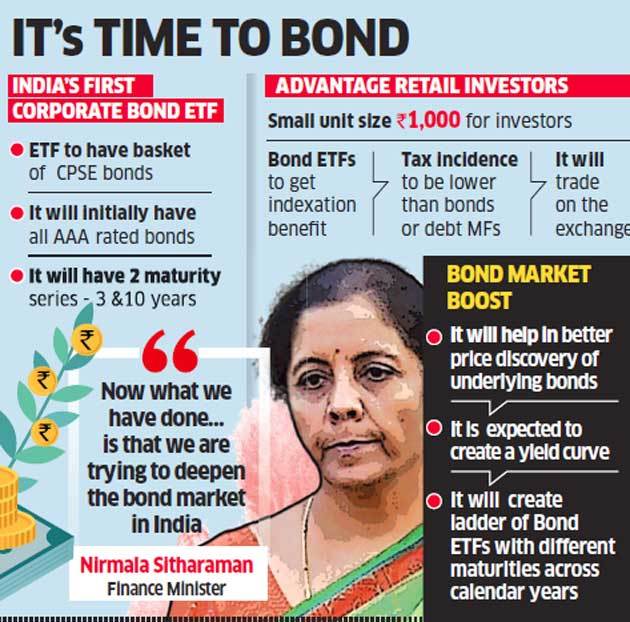India’s first debt Exchange Traded Fund, Bharat Bond 06/12/2019 – Posted in: Daily News – Tags: bombay stock exchange, Bond Credit Rating, Credit Rating Agencies, national stock exchange
Bharat Bond Exchange Traded Fund
For: Preliminary & Mains
Topics covered:
- About Bharat Bond
- About AAA-rated bonds
- About NSE and BSE
- About Credit Rating Agencies
- About Bond Credit Rating
News Flash
The government has approved India’s first debt Exchange Traded Fund, Bharat Bond, comprising debt of state-run companies, a move that will allow retail investors to buy government debt. It will be the first corporate bond ETF, which will provide additional money for PSUs as well as other government organisations. Bharat Bond Exchange Traded Fund will be managed by Edelweiss Asset Management.
ETFs invest in a basket of securities representing an index, security or commodity and are traded on the stock exchange. It will provide retail investors easy and low-cost access to bond markets, with smaller amount as low as Rs.1,000.
The government has so far allowed only equity ETFs, and the government raised nearly Rs.14,400 crore through ETFs in the 2019/20 fiscal year beginning April.
Retirement fund body Employees Provident Fund (EPFO), has invested about Rs.87000 crore in ETFs.
Key Highlights
- Bharat Bond ETF will be a basket of bonds issued by central public sector enterprises/undertakings or any other government organization bonds. (Initially, all AAA-rated bonds.)
- Bharat Bond ETF will have a fixed maturity of three and ten years and will trade on the stock exchanges.
- It will invest in a portfolio of bonds of state-run companies and other government entities.
- Bharat ETF will track an underlying index on risk replication basis, matching credit quality and average maturity of the index. The index will be constructed by an independent index provider, National Stock Exchange.
- Bharat bond ETF would enable deepening the corporate bond market with enhanced retail participation.
- The 0.0005% cost structure makes it the cheapest available investment option.
- Bond ETF will provide safety (underlying bonds are issued by CPSEs and other government-owned entities), liquidity (tradability on exchange) and predictable tax-efficient returns.
- Bond ETFs will provide tax efficiency as compared to bonds, as coupons (interest) from the bonds are taxed depending on the investor’s tax slab. Bond ETFs are taxed with the benefit of indexation which significantly reduces the tax on capital gains for investors.
- Long-term capital gains (holding period of over 3 years) on bond funds are taxed at 20% after indexation. Indexation is the process of adjusting the purchase price of an investment for inflation, which helps bring down the quantum of capital gains.
AAA-rated bonds
- It is the highest possible rating that may be assigned to an issuer’s bonds by any of the major credit rating agencies.
- AAA-rated bonds are perceived to have the smallest risk of default, these instruments tend to offer investors the lowest yields among bonds with similar maturity dates.
- AAA-rated bonds often give the issuing competitive edges over lower-ranked bonded companies.
Bond Credit Rating
- In investment, the bond credit rating represents the creditworthiness of corporate or government bonds.
- The ratings are published by credit rating agencies and used by investment professionals to assess the likelihood the debt will be repaid.
Credit Rating Agencies
- A credit rating agency is a company that assigns credit ratings, which rate a debtor’s ability to pay back debt by making timely principal and interest payments and the likelihood of default.
- Credit rating is a highly concentrated industry with the “Big Three” credit rating agencies — Fitch Ratings, Moody’s and S&P — controlling approximately 95% of the ratings business.
- The debt instruments rated by CRAs include government bonds, corporate bonds, CDs, municipal bonds, preferred stock, and collateralized securities, such as mortgage-backed securities and collateralized debt obligations.
National Stock Exchange of India Limited (NSE)
- Located in Mumbai, established in 1992, NSE is the leading stock exchange of India.
- NSE was the first exchange in the country to provide a modern, fully automated screen-based electronic trading system which offered easy trading facility to the investors spread across the length and breadth of the country.
- National Stock Exchange’s flagship index, the NIFTY 50, the 50 stock index is used extensively by investors in India and around the world as a barometer of the Indian capital markets.
- Nifty 50 index was launched in 1996 by the NSE.
The Bombay Stock Exchange
- BSE is an Indian stock exchange located at Mumbai.
- Established in 1875, the BSE (formerly known as Bombay Stock Exchange Ltd.) is Asia’s first stock exchange.
- BSE became the first stock exchange to be recognized by the Indian Government under the Securities Contracts Regulation Act.
- The Bombay stock exchange was founded by Premchand Roychand, an influential businessmen in 19th-century Bombay.
- The BSE is also a Partner Exchange of the United Nations Sustainable Stock Exchange initiative, joining in September 2012.
- BSE established India INX on 30 December 2016. India INX is the first international exchange of India.
- BSE launches commodity derivatives contract in gold, silver.
Source: Livemint
READ MORE DAILY NEWS
- Coalbed Methane
- Supreme court on Electronic Evidences
- VoWi-Fi Technology
- The draft Registration of Press and Periodicals Bill, 2019
- Industrial Relations Code Bill, 2019
- Global Migration Report 2020
- Joint military exercise ‘SURYA KIRAN – XIV’
- Gandhipedia
You are on the Best Online IAS preparation platform. You are learning under experts.
We are present on Facebook- Diligent IAS, LinkedIn- Diligent IAS, YouTube- Diligent IAS, Instagram- Diligent IAS. Get in touch with us.

